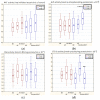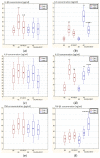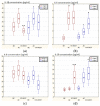The Influence of Ambient Temperature Changes on the Indicators of Inflammation and Oxidative Damage in Blood after Submaximal Exercise
- PMID: 36552653
- PMCID: PMC9774713
- DOI: 10.3390/antiox11122445
The Influence of Ambient Temperature Changes on the Indicators of Inflammation and Oxidative Damage in Blood after Submaximal Exercise
Abstract
Physical activity has a positive effect on human health and well-being, but intense exercise can cause adverse changes in the organism, leading to the development of oxidative stress and inflammation. The aim of the study was to determine the effect of short-term cold water immersion (CWI) and a sauna bath as methods of postexercise regeneration on the indicators of inflammation and oxidative damage in the blood of healthy recreational athletes. Forty-five male volunteers divided into two groups: 'winter swimmers' who regularly use winter baths (n = 22, average age 43.2 ± 5.9 years) and 'novices' who had not used winter baths regularly before (n = 23, mean age 25 ± 4.8 years) participated in the study. The research was divided into two experiments, differing in the method of postexercise regeneration used, CWI (Experiment I) and a sauna bath (Experiment II). During Experiment I, the volunteers were subjected to a 30-min aerobic exercise, combined with a 20-min rest at room temperature (RT-REST) or a 20-min rest at room temperature with an initial 3-min 8 °C water bath (CWI-REST). During the Experiment II, the volunteers were subjected to the same aerobic exercise, followed by a RT-REST or a sauna bath (SAUNA-REST). The blood samples were taken before physical exercise (control), immediately after exercise and 20 min after completion of regeneration. The concentrations of selected indicators of inflammation, including interleukin 1β (IL-1β), interleukin 6 (IL-6), interleukin 8 (IL-8), interleukin 8 (IL-8), interleukin 10 (IL-10), transforming growth factor β1 (TGF-β1) and tumor necrosis factor α (TNF-α), as well as the activity of indicators of oxidative damage: α1-antitrypsin (AAT) and lysosomal enzymes, including arylsulfatase A (ASA), acid phosphatase (AcP) and cathepsin D (CTS D), were determined. CWI seems to be a more effective post-exercise regeneration method to reduce the inflammatory response compared to a sauna bath. A single sauna bath is associated with the risk of proteolytic tissue damage, but disturbances of cellular homeostasis are less pronounced in people who regularly use cold water baths than in those who are not adapted to thermal stress.
Keywords: cold water immersion; cytokines; exercise; inflammation; lysosomal enzymes; oxidative stress; sauna bath; serine protease inhibitor.
Conflict of interest statement
The authors declare no conflict of interest.
Figures












Similar articles
-
The Effect of Submaximal Exercise Followed by Short-Term Cold-Water Immersion on the Inflammatory State in Healthy Recreational Athletes: A Cross-Over Study.J Clin Med. 2021 Sep 18;10(18):4239. doi: 10.3390/jcm10184239. J Clin Med. 2021. PMID: 34575347 Free PMC article.
-
Effects of thermal stress on the activity of selected lysosomal enzymes in blood of experienced and novice winter swimmers.Scand J Clin Lab Invest. 2012 Dec;72(8):635-41. doi: 10.3109/00365513.2012.727214. Epub 2012 Oct 15. Scand J Clin Lab Invest. 2012. PMID: 23061673 Clinical Trial.
-
The oxidant-antioxidant equilibrium, activities of selected lysosomal enzymes and activity of acute phase protein in peripheral blood of 18-year-old football players after aerobic cycle ergometer test combined with ice-water immersion or recovery at room temperature.Cryobiology. 2017 Feb;74:126-131. doi: 10.1016/j.cryobiol.2016.11.004. Epub 2016 Nov 18. Cryobiology. 2017. PMID: 27871846
-
Optimizing Cold-Water Immersion for Exercise-Induced Hyperthermia: An Evidence-Based Paper.J Athl Train. 2016 Jun 2;51(6):500-1. doi: 10.4085/1062-6050-51.9.04. Epub 2016 Jul 21. J Athl Train. 2016. PMID: 27441949 Free PMC article. Review.
-
Water immersion recovery for athletes: effect on exercise performance and practical recommendations.Sports Med. 2013 Nov;43(11):1101-30. doi: 10.1007/s40279-013-0063-8. Sports Med. 2013. PMID: 23743793 Review.
Cited by
-
The Effect of Physical Activity and Repeated Whole-Body Cryotherapy on the Expression of Modulators of the Inflammatory Response in Mononuclear Blood Cells among Young Men.J Clin Med. 2024 May 6;13(9):2724. doi: 10.3390/jcm13092724. J Clin Med. 2024. PMID: 38731252 Free PMC article.
-
The Impact of Neck Cooling on Serum Oxidant/Antioxidant Status and HSP70 Levels during High-Intensity Cycling.Life (Basel). 2023 Nov 8;13(11):2178. doi: 10.3390/life13112178. Life (Basel). 2023. PMID: 38004318 Free PMC article.
-
Impact of different doses of cold water immersion (duration and temperature variations) on recovery from acute exercise-induced muscle damage: a network meta-analysis.Front Physiol. 2025 Feb 26;16:1525726. doi: 10.3389/fphys.2025.1525726. eCollection 2025. Front Physiol. 2025. PMID: 40078372 Free PMC article.
-
Brief extreme passive heat exposure leads to elevated biomarkers of systemic inflammation and acute kidney injury in older vs young adults.Eur J Appl Physiol. 2025 Jun 23. doi: 10.1007/s00421-025-05827-w. Online ahead of print. Eur J Appl Physiol. 2025. PMID: 40549207
-
The Influence of Winter Swimming on Oxidative Stress Indicators in the Blood of Healthy Males.Metabolites. 2023 Jan 17;13(2):143. doi: 10.3390/metabo13020143. Metabolites. 2023. PMID: 36837762 Free PMC article.
References
-
- Accattato F., Greco M., Pullano S.A., Carè I., Fiorillo A.S., Pujia A., Montalcini T., Foti D.P., Brunetti A., Gulletta E. Effects of Acute Physical Exercise on Oxidative Stress and Inflammatory Status in Young, Sedentary Obese Subjects. PLoS ONE. 2017;12:e0178900. doi: 10.1371/journal.pone.0178900. - DOI - PMC - PubMed
LinkOut - more resources
Full Text Sources
Research Materials
Miscellaneous

